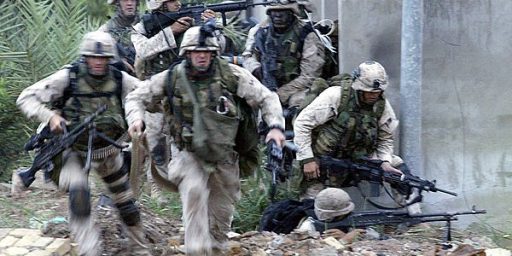Fake Photos and Insurgent Imagery
Neil Munro has a long look at the use of images in war and how much they have changed given modern technology.
Thanks to digital technology, the wars in Iraq and Afghanistan are the most photographed in history. Photographers with digital cameras have provided, almost instantaneously, an enormous flood of accurate, dramatic, and even shocking images to people around the world. But the daily downloads of news photos include some that are staged, fake, or so lacking in context as to be meaningless, despite the Western media’s best efforts to separate the factual from the fictional.
Indeed, quite literally, a picture may no longer be worth a thousand words and the answer to “Who you gonna believe, me or your lyin’ eyes?” is no longer obvious.
Particularly interesting, though, is what he dubs “Insurgent Imagery.”
It is not just photographers or their editors who can manipulate images. Terrorists anywhere, and insurgents in Iraq specifically, can and do manipulate photos for their own uses. In Iraq, insurgents have displayed and passed around, for example, pictures said to show U.S. soldiers raping Iraqi women. They have also circulated photos of “giant spiders” supposedly sent by Allah to save Falluja from the Americans. The pictures were, in fact, crude photocopies of an American soldier’s souvenir photo of two connected solifugids, also known as camel spiders, which are native to Iraq. In the photo, a soldier was holding up the two connected arachnids before an audience of other soldiers, according to Nir Rosen, a writer and a fellow at the New America Foundation, who stayed with insurgents in Falluja.
“If you went into anyone’s house in Falluja, they had pictures of it…. People believed,” Rosen said of the camel spiders. In the photograph, the arachnids, which are about the size of a human hand, seem larger than life because the two look like one large insect and because the soldier’s hand holding the creatures is unseen. Without the hand as a visual reference, viewers are prompted to compare the camel spiders’ size to the soldier’s leg in the background, making them look three or four feet long.
The supposed rape pictures were far more important, Rosen said. In a February article for The New York Times Magazine, Rosen quoted a Jordanian Islamist’s testimony that the pictures helped to galvanize insurgent activity in Falluja. “In the beginning, [the Fallujans] had said to the insurgents, ‘Go make jihad in your own country.’ After the rape story, they said, ‘OK, we want to start now, or tomorrow we will find our mothers or daughters or sisters raped.’ This story exploded the resistance in Falluja. They called us for a meeting and said, ‘You were right.'” Rosen told National Journal that the rape pictures resembled those now displayed on a Web site maintained by a radical U.S. Hispanic group, La Voz de Aztlan Communications Network. The men in those pictures have their faces concealed, they are wearing a hodgepodge of military clothing, and they do not carry any weapons or equipment worn by U.S. soldiers. According to a January 2004 article in The Boston Globe, these rape photo claims were repeated in the Turkish Islamist press, possibly contributing to at least one suicide bomb attack in Turkey that killed 11 people. The State Department worked hard, and successfully, to rebut the claims. “It was such an obviously bogus story, we came out pretty well,” said a spokesman for the American Embassy in Turkey. Since then, “the atmosphere here is much improved.”
Of course, to use yet another cliche, a lie travels halfway around the world before the truth can get its boots on. Even once definitively debunked, the staged propanda is believed by many.



